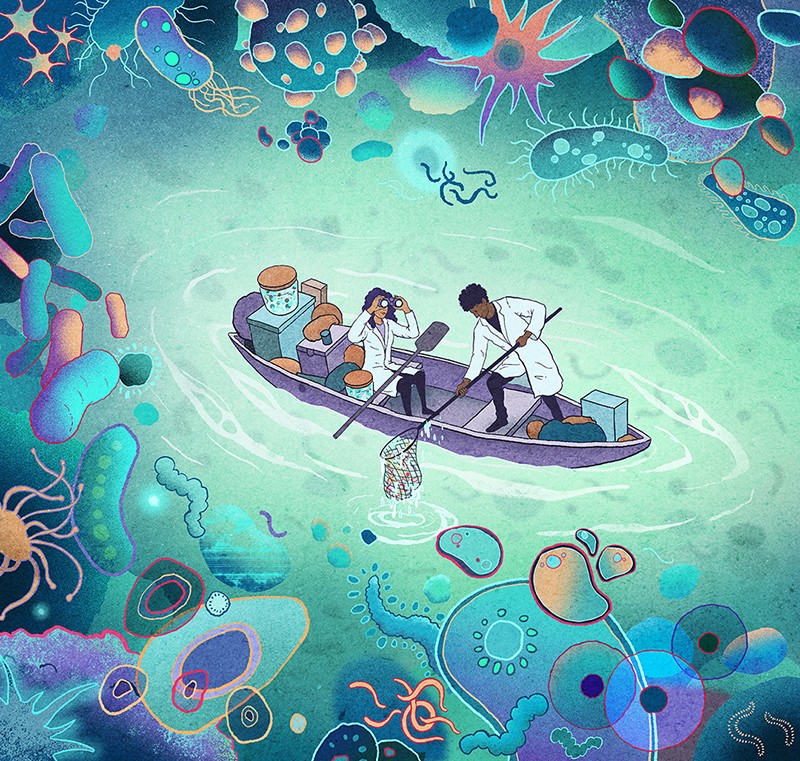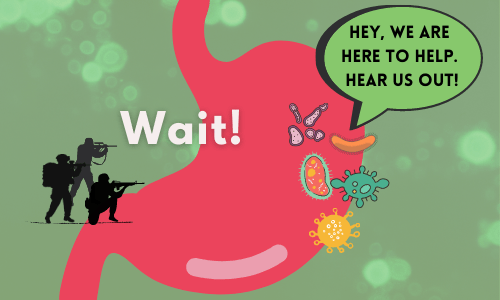The normal flora of the human body consists of trillions of microorganisms. Human microbiota are microbes that colonize our skin, nose, throat, mouth, gut and vagina and are normally harmless.
The majority of the bacterial population is found in the gut. These gut microbes do not harm the host, but in turn, they depend on humans for their growth and survival. They aid us in various processes like digestion, absorption of nutrients, synthesis of vitamins, outcompeting harmful bacteria and strengthening the intestinal barrier. The gut microbes provide essential requirements for the fermentation of non-digestible substances like dietary fibers.

This fermentation aids the growth of several bacteria that create various types of short chain fatty acids (SCFA). The most important metabolites are acetate, propionate, and butyrate, which contribute to anti-inflammatory activity by training the immune system and preventing pathogen growth. They provide fuel for intestinal cells, regulating gut hormones and hunger and reducing diet-induced obesity.
Gluten sensitivity
Gluten is a protein found in grains such as wheat, barley, and rye. Gluten sensitivity is triggered when these grains are ingested by the individuals with genetic or immunologic susceptibility to this condition. There are two different types of gluten intolerance:
- Celiac disease is an autoimmune disorder in which the body’s immune system targets and destroys healthy tissue by mistake. It can also be caused by a hereditary susceptibility to gluten intolerance. Even a small amount of gluten-containing food can cause serious damage to the small intestine lining, reducing the area available for nutritional absorption. This results in bloating, discomfort, diarrhea, constipation, vomiting, exhaustion, and depression.
- Non-Celiac Gluten sensitivity is a non-autoimmune condition that is characterized by the gut’s inability to tolerate any form of gluten protein. When gluten is removed from the diet, the symptoms of non-celiac gluten sensitivity go away.
Lactose intolerance
People with lactose intolerance are unable to digest significant amounts of lactose due to an insufficient amount of the enzyme lactase, which is required for the breakdown of lactose present in milk and milk products.
Every individual, except for a few, has the ability to produce lactase enzymes from the time they’re born, which help in the digestion of lactose. But as we age, the levels of lactase enzyme in the body decline, and in some individuals, it leads to indigestion of lactose. Within a few hours of consuming milk or milk products, the undigested lactose is transported to the colon, where it is broken down by gut bacteria to produce SCFA and excess gas, causing abdominal pain, bloating, flatulence, and watery stool.
The gut brain axis
Every person goes through a phase in their life where they probably have to make a decision or experience something called a “gut feeling” or “butterflies in the gut” when they are nervous. The gut-brain axis (GBA) involves the brain, spinal cord, the HPA axis, and the ENS, along with millions of neurons that innervate our gut and brain. Immune activation, intestinal permeability, enteric reflex, and intestinal endocrine signaling are all monitored and integrated by the GBA. It connects the brain’s emotional and cognitive centers to gut processes and systems.
Some neurotransmitters, such as serotonin, dopamine, and melatonin, are produced by gut microorganisms and delivered to the brain via millions of neurons. People with psychological disorders suffer from microbial dysbiosis and have different species of bacterial community as compared to healthy people. Exposure to traumatic events as a child, substance misuse, and poor nutritional choices, as well as stressful conditions, lead to persons engaging in unhealthy behaviors such as lack of sleep and improper eating choices. These habits contribute to illnesses including depression, anxiety, and inflammatory bowel disease (IBD) by causing inflammation and disrupting neurotransmitter balance.
Effect of antibiotics on the gut microbiota
Antibiotics may be used to treat a variety of disorders. They are lethal to both disease-causing and beneficial bacteria that live in our gut. Antibiotics fight against bacteria by preventing them from performing vital functions or by preventing them from reproducing.
Antibiotic use can cause dysbiosis of the gut microorganisms. As a result, there may be a decrease in microbial diversity, as well as the loss of helpful bacteria, a shift in metabolism, and diminished resistance to invading pathogens, thereby increasing susceptibility to intestinal infections. Gut dysbiosis also promotes the transfer of resistance genes, the evolution of drug-resistant pathogens and the spread of antibiotic resistance. Over the counter use of antibiotics for self-treating conditions such as colds, which are not even caused by bacteria but by viruses, makes it impractical and, in turn, might be detrimental to the good bacteria.

The most common side effect of consuming antibiotics is diarrhea that contains mostly dead gut bacteria. The use of antibiotics in children and elderly people can be problematic as their gut microbes are already less stable and have a slow recovery rate.
Antibiotic misuse is on the rise in today’s world, owing to their widespread usage in livestock and agriculture, as well as failure to complete recommended antibiotic courses, which leads to antimicrobial drug resistance.
Antibiotic resistance renders existing antibiotics ineffective against pathogenic bacteria, resulting in a rise in the proliferation of resistant germs, which in turn worsens infection severity.
Probiotics
Probiotics are live microbial food ingredients that supplement the gastrointestinal flora; the most common organisms are the Lactobacilli and Bifidobacter species. Probiotics have been shown to inhibit pathogenic bacteria in both in-vivo and in-vitro investigations, making them useful against a variety of gastrointestinal illnesses.
Yogurt and probiotic lactic acid bacteria aid in lactose digestion. It works in the intestine by lowering its concentration in fermented foods and increasing the concentration of active lactase enzyme, which acts on ingested lactose and alleviates maldigestion symptoms.
Probiotics are also effective in reducing side effects caused by antibiotics used to cure infections caused by Helicobacter pylori, the causative agent of stomach ulcers.
Prebiotics
Prebiotics are non-digestible food ingredients that benefit the host by selectively stimulating the growth and activity of a limited number of bacteria in the gut and improving host health. Commercially available prebiotics are fructooligosaccharides (FOS), inulin, lactulose, and galactooligosaccharides.
Prebiotics decrease the activity of microbial enzymes involved in the production of cancer-causing agents. While lactulose provides protection against DNA damage in animal models when challenged with active carcinogens, inulin and FOS reduce the number and size of tumors in rats with induced cancer.
As a result, a well-balanced diet is essential for maintaining good intestinal health, and being conscious of our gut health is critical for eliminating illnesses such as gluten sensitivity, lactose intolerance, depression, and IBD.
Reference:
- https://www.ncbi.nlm.nih.gov/pmc/articles/PMC4768623/
- https://www.nm.org/healthbeat/healthy-tips/nutrition/go-with-your-gut-4-facts-about gluten-intolerance
- https://doi.org/10.1080/10408398.2018.1425977
- https://pubmed.ncbi.nlm.nih.gov/26438584/
- https://pubmed.ncbi.nlm.nih.gov/12927512/
. . .
Writer

Chitrika Salian
Chitrika is a graduate in Biotechnology from Khalsa College, Mumbai. Her interest lies in stem cells, cancer cells and Immunology.
Illustrator


